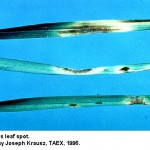Bipolaris, Drechslera and Exserohilum Leaf Spot, Crown and Root Rot (fungi – Bipolaris cynodontis, Drechslera gigantea, Bipolaris stenospila, Curvularia spp. and Exserohilum spp
Host Grass: Hybrid Bermuda(Cynodon dactylon), Common Bermuda, Perennial Ryegrass(Lolium perenne), Zoysiagrass(Zoysia japonica)
Cause and Symptoms: Helminthosporium type diseases develop during warm weather when cyclical patterns of wetting and drying occur in the thatch layer. Symptoms often appear on leaf blades (leaf spots) in cool weather and as crown and root rots (melting-out) in hot humid weather.  In early stages, severely affected turf has a purple cast and the turfgrass thins. Often the condition becomes advanced before a disease is suspected and verified by the presence of leaf spots. Fading-out is most prevalent on turfgrass weakened by other disease-causing organisms, insect pests, nematodes or improper cultural practices. Small, brown-to-purple lesions with tan centers occur on leaf blades. Leaf spots are commonly found near the collar area of the leaf blade. Severely affected leaves turn reddish-brown, then wither and die. When temperatures exceed 85oF or under severe disease conditions, a sheath and crown rot may occur with turfgrass killed in patches.
In early stages, severely affected turf has a purple cast and the turfgrass thins. Often the condition becomes advanced before a disease is suspected and verified by the presence of leaf spots. Fading-out is most prevalent on turfgrass weakened by other disease-causing organisms, insect pests, nematodes or improper cultural practices. Small, brown-to-purple lesions with tan centers occur on leaf blades. Leaf spots are commonly found near the collar area of the leaf blade. Severely affected leaves turn reddish-brown, then wither and die. When temperatures exceed 85oF or under severe disease conditions, a sheath and crown rot may occur with turfgrass killed in patches.
Control and Management: The following cultural practices all contribute to healthy grass that resists development of weak pathogens: Maintain adequate fertility, giving special attention to levels of nitrogen and potassium, Aerate to eliminate soil compaction, Provide good drainage, Avoid herbicide applications during periods of disease activity, Water adequately, but not excessively or too frequently, Mow at the proper height, Avoid thatch build-up. Fungicide applications hasten recovery of affected turf. However, they should be used in combination with good cultural practices. Preventive fungicide applications (See the section Chemical Controls for Turfgrass Diseases) are more effective than treating a severe outbreak.
Content edited by: Young-ki Jo, ykjo@tamu.edu , Assistant Professor and Extension Specialist, Dept Plant Pathology & Microbiology, Texas A&M University, Texas AgriLife Extension Service, May 31, 2013
